

 PAT PETTETT looks at the HO/OO range of Kato Unitrack.
PAT PETTETT looks at the HO/OO range of Kato Unitrack.
One of the lesser known track systems (to UK modellers at least) is the Kato Unitrack range – the N Scale system is perhaps the best known and most extensive. However, here I will be taking a look at the HO scale system.
Kato Unitrack has a ballast base, similar to the Fleischmann Profi-track and Roco Geoline systems. Most UK outline track systems have rails and sleepers, but no ballast base – as such they are best used on a baseboard, pinned down. They aren’t best suited to playing on the carpet, if a section of track was kicked or stood on the fishplates are very vulnerable. The benefit of track with a ballast base is that the plastic base connects together in addition to the fishplates, and the track copes much better with minor knocks and bashes. It also makes the track much happier to be laid, lifted and relaid again many times – I have a 5 year old daughter and we love making fresh layouts!
Japanese homes are often on the small side, and the consequence of this is that Japanese modellers often lack the space for a permanent layout. The approach they take when they want a running session is to build the layout, then pack it all away again at the end of the day’s running – Kato track is designed to cope with from the outset. Whilst this would not fit the definition of a layout in terms that UK modellers would be familiar with, it is ideal at the track planning stage and ideal for those enthusiasts who have space constraints, or modellers of a certain age with a mortgage, three kids, and a cat and nowhere for a permanent layout until some of the offspring leave the nest in what seems like many years time...
My modelling interests have naturally taken a bit of a back seat, but I can’t wait years without playing trains! When I first saw the Unitrack system it was an answer to my prayers – something with proven durability, a decent appearance and that could be slung on the lounge carpet quickly and cleared away just as quickly when dinnertime intrudes on playtime.
So what is the track like?
The most common rail used in UK modelling is code 100 – if you have Hornby track or Peco Setrack this is the rail you have. Finescale track is offered by Peco in their Streamline range, this is code 75 and is finer in appearance (the lower the number the finer the rail, at the other end of the scale G scale track is around code 330).
American modellers often use code 83 track – noticeably finer than our code 100 and this is the profile of the HO Unitrack range.
Seen below end on, the rail profile is noticeably finer than the Hornby Setrack or the Fleischmann Profi – and from a side on view the lower rail height can clearly be seen – it is a very good looking track!
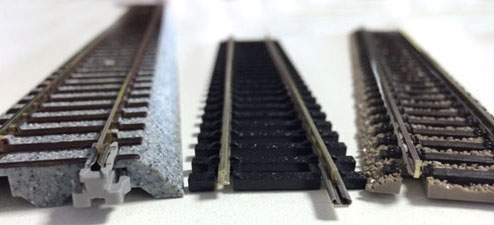
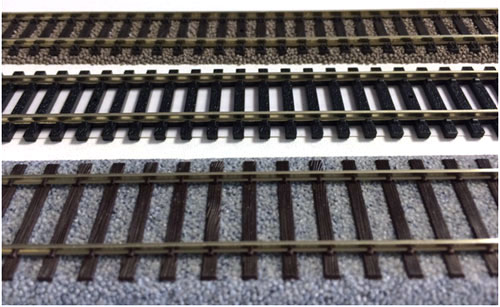
The range of curve radii available is very handy – for UK outline modelling, major manufacturers like Bachmann and Hornby specify a minimum radius of 438mm – Both Hornby and Peco previously offered three track radii, but as standards of ready to run models have improved over the years it has meant that modern models need a little more space than the Tri-ang Hornby we grew up with. To keep three useful track radii in the range, both Peco and Hornby introduced 4th radius track, at 572mm. The former first radius is fine for small tank locos, but larger express classes and longer models simply won’t go round without straining and possibly derailing. The introduction of the fourth radius meant it was possible for the track plan books offered by both Hornby and Peco to continue to offer layouts with three running lines.
With the HO Unitrack, there are plenty of curve radii available – the closest to our magic minimum of 438mm is 430mm – most UK outline locos will happily take this. The track spacing is 60mm between parallel tracks, so increasing in size from 430mm we have 490mm (very close to UK radius 3) then 550mm, then 610mmm etc. Heading in the other direction, we have 370mm – ever so slightly bigger than Continental first radius of approx 365mm as offered by Fleischmann etc. Not so much use to us UK modellers but useful for certain sections – industrial or factory lines with small tank locos scurrying about with wagons for example.
Points are available in 3 radii – 490mm, 550mm and a much smoother 867mm for sweeping junctions and great for station approaches. The 490mm radius points are delivered for manual operation, but point motors are available that simply slot into the side of the point. The 550mm radius points are delivered with motors built in, and the 867mm radius points are available in manual and motorised form – the manual version of these is much bigger and is a single large section, whereas the electric versions are delivered with an assortment of extra pieces to enable various connections and layouts to be made.
Let’s take a closer look at the pointwork – firstly the electric 550mm radius points. We get more than the point itself with these:
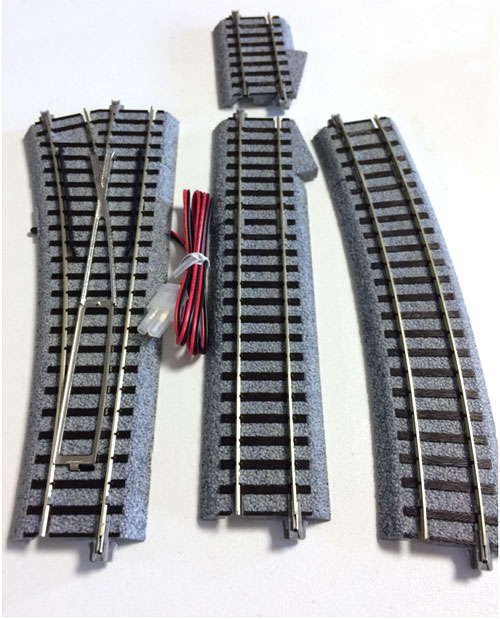
We can see that the curve matches the curve of the point:
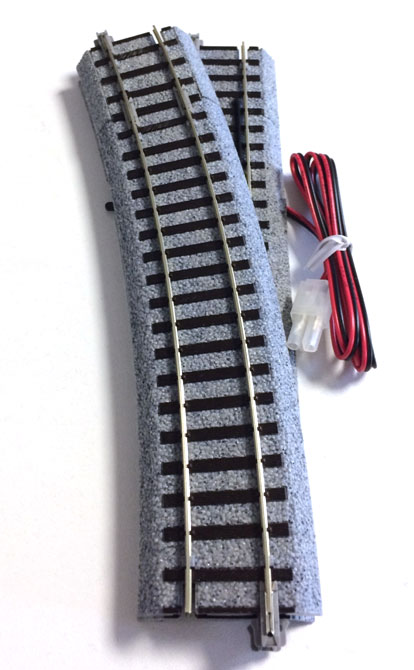
And on closer examination, there is a removable section at the end:
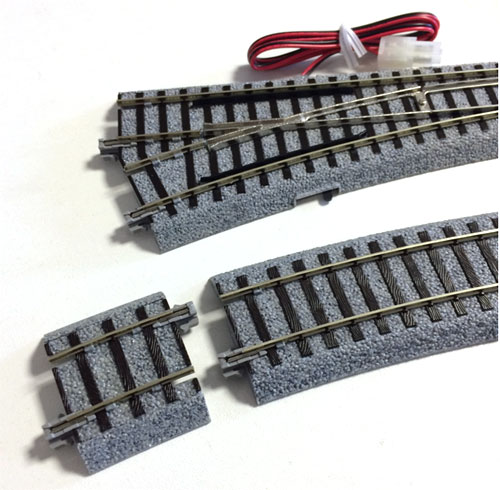
The ballast shoulders of both this small curve and the point itself can be removed:
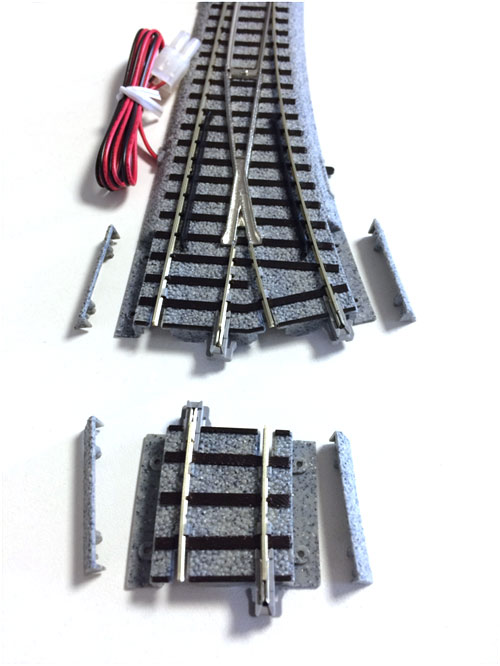
So what is that for then? If we connect a straight to the end of the point, we can see that there is not enough room for the adjacent track to fit:
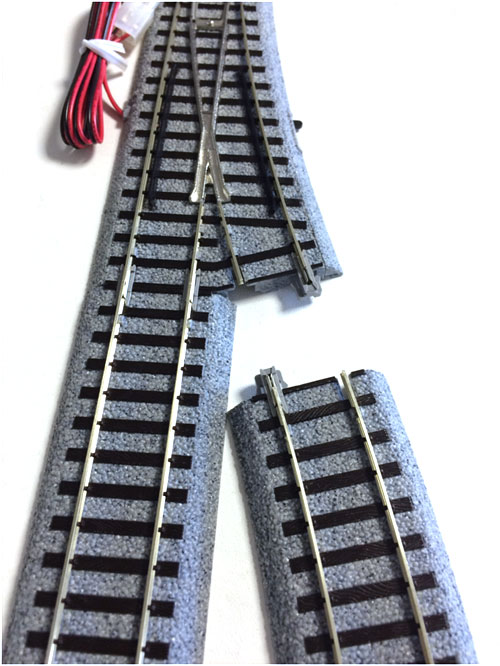
This is where the strange short straights come into play – if we connect one of those instead, there is enough room for the little curve (with shoulder removed) to fit in:
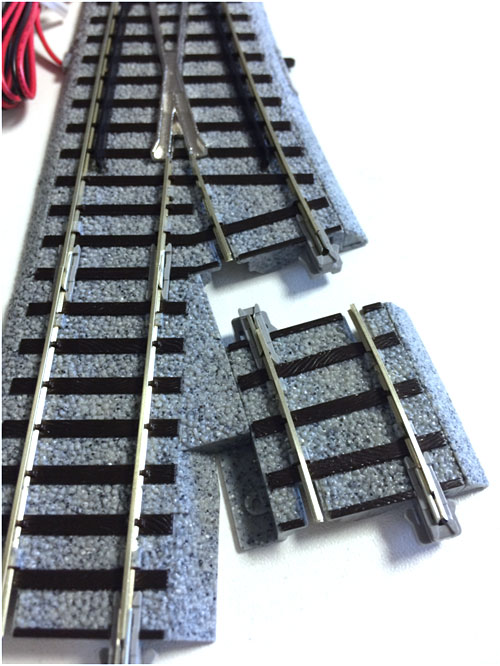
The longer straight can now connect to the small straight, and by adding the larger curve we now have a flush end with 60mm spacing:
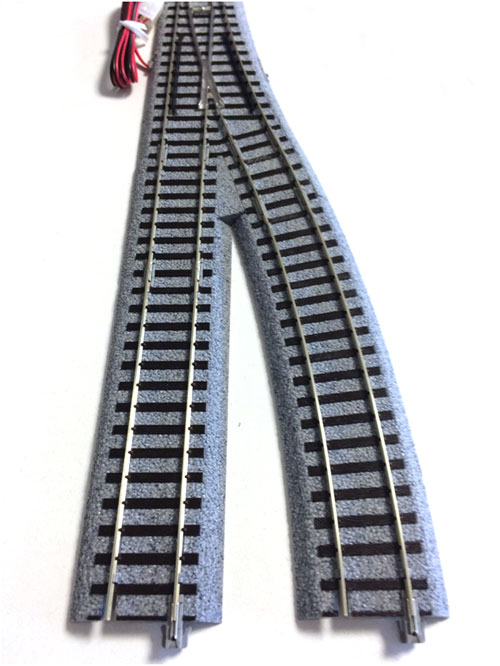
The shoulders on the point itself can be removed too – this allows you to make crossovers, again with the 60mm spacing:
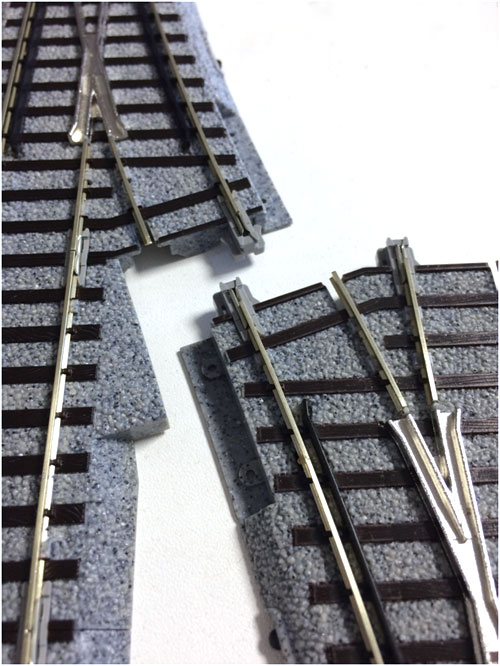
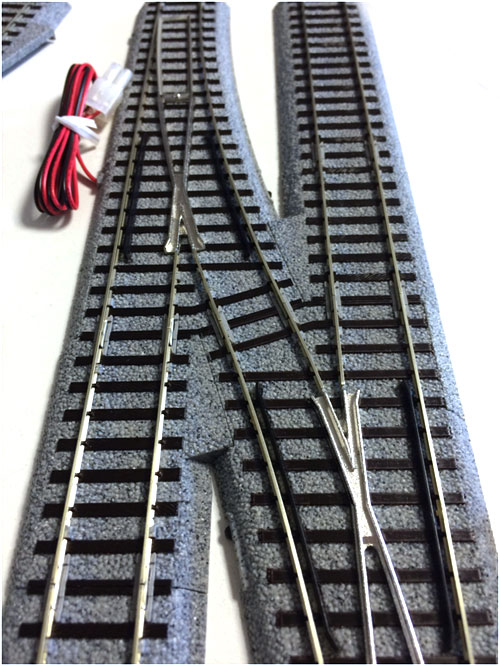
The larger radius points work on a similar principle – once again fresh out of the box:
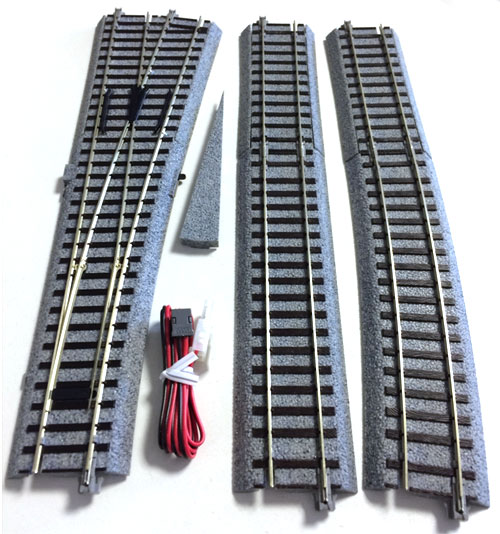
Once again, the two short straight sections have removable shoulders:
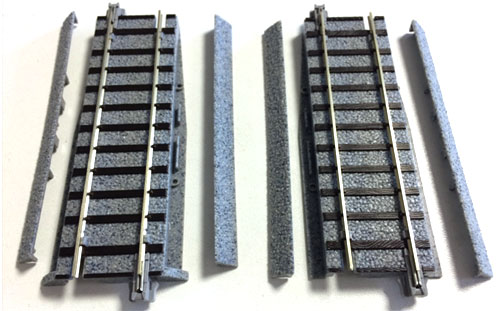
Notice also the slight taper towards one end – this allows them to connect to the point without the ballast getting in the way. The triangular section fits into the resulting gap:
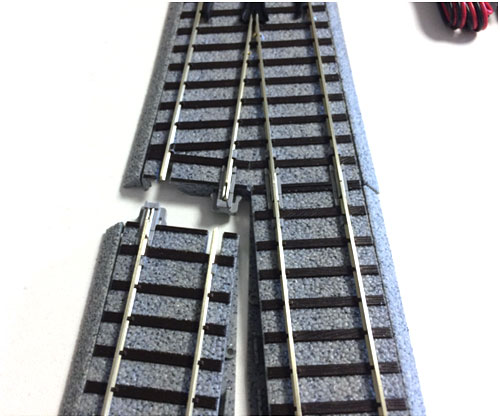
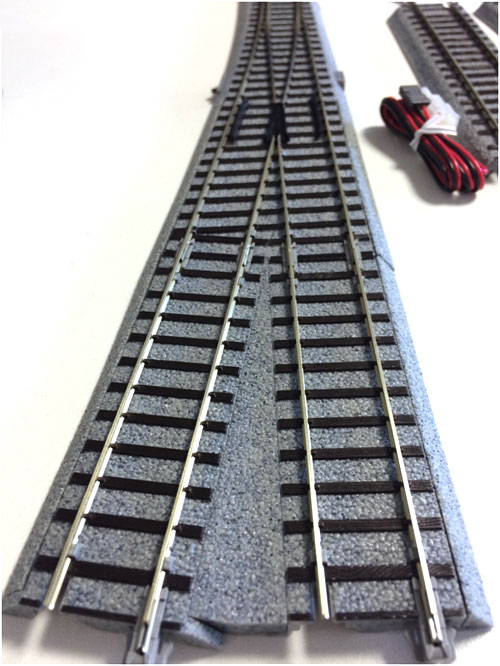
Again the shoulders of the point are removable too, and the one on the straight side reveals some little black terminals:
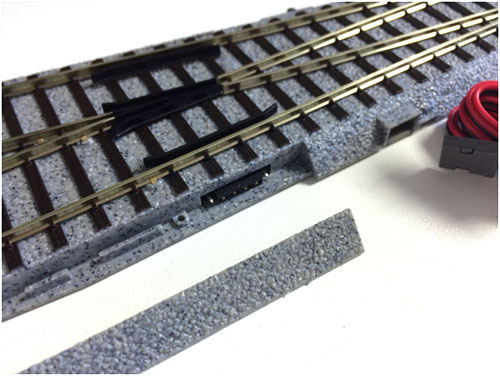
These are jumper terminals – by moving them along one slot, we can change the point from isolating to non isolating depending on whether we are running DCC or analogue. The connection for the point motor lies alongside this.
Kato point motors differ from most, in that they use a two wire system, not three – so your conventional solenoid switches will not work. Kato do of course offer their own point switches – these can take power from the Kato controller, they simply clip to the side. If you are running DCC, DCC Concepts offer converters that will allow any solenoid decoder to control 2 wire points:
If we are starting out, Kato offer starter track packs and extension packs, much like the N gauge range. My Unitrack journey started with their “world’s greatest hobby” pack, K3-103, (the closest now is the K20-853 Unitrack (BM2) Oval/Passing Loop Track Set with Controller):
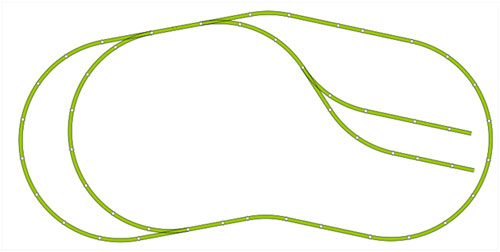
This is a great value pack – designed for an 8 foot by 4 foot board or area and the layout suggestion is less geometric than many UK plans, and there is sufficient track to play around with various shapes- no plain ovals here!
The basic plan has a passing loop at one end, and a small yard in the inner area of the other end. If we add a couple of the 114mm long straight sections, we can make a more conventional passing loop, and make the sidings longer in the process:
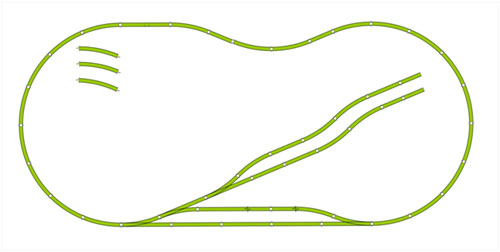
Track planning software is very useful, but there is still mileage in getting down to it and physically seeing what you can do – here myself and offspring are doing just that with Superquick buildings, Oxford Diecast buses and a few of my Bachmann multiple units:
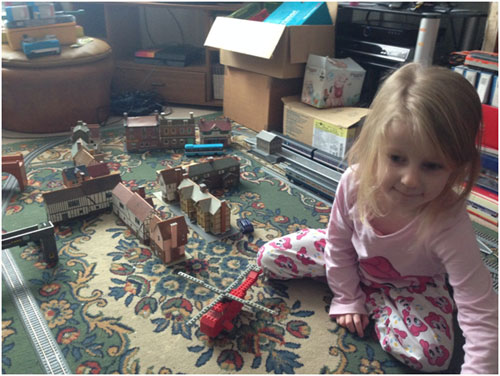
This is an oval using the 490mm radius track, and the matching points. As we can see below, mucking about with track on the floor led me to the discovery that Hornby platform fits nicely in between the track gap left by using these points – this is one of many layouts me and Amber made that afternoon!
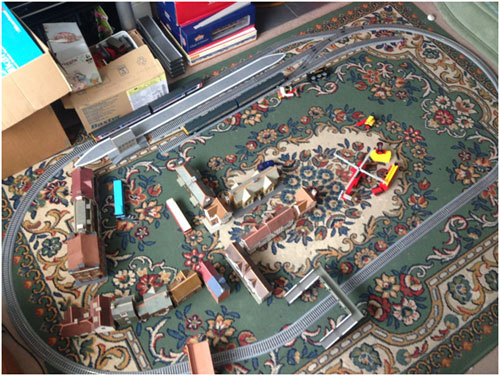
Overall it is an excellent track range, for building layouts, working up to building a layout, testing, even just mucking about for a fun afternoon.